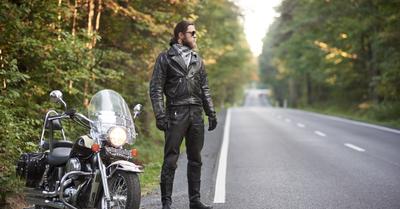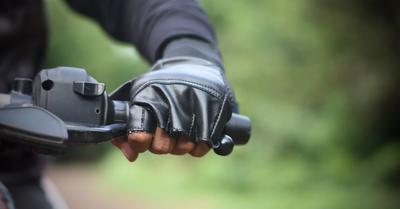How to Wear Long Hair Under a Motorcycle Helmet
While motorcycle helmets are essential safety accessories, the truth is that they are designed to protect our heads, not worry about our hair. A helmet wearer has a better chance of surviving an accident. I am glad to suffer a little bit of helmet head if it means I get to ride another day..
Longer Hair
If your hair is longer than the helmet, you will need to secure it. There are lots of ways that you can make sure that your hair stays where it belongs.
Elastic Tie or Scrunchie
The simplest solution is to put hair into a ponytail or small bun (like a man bun) and secure it with a scrunchie or a fabric band. While the helmet might “squish” the balled or bunched hair a bit, it will bounce right back as soon as you remove your helmet and unwind your hair. Be sure to tuck the hair below the helmet and tuck it under your jacket coat to stay in place.
Balaclava, Bandana or Neckgaitor
If securing your hair with a scrunchie is not an option, consider storing it in a balaclava, head scarf, bandana, or neck gaiter. Many companies make pre-tied bandanas or skull caps that can be used to hold hair to the back of the neck.
A balaclava is a full-fledged ski mask with an opening for the eyes and nose. It covers the head, mouth, and neck. Long hair can be positioned behind the ears, secured with a tie, pins, or braided, and kept in place by the balaclava. If you like Ninja, then this might be the method you want to go with.
A neck gaiter is a tubed cloth that can stretch tightly over the forehead to the base of the head and uses elasticity to help contain hair. It is easy to wear around the neck when not in use. Unlike the Balaclava, it doesn’t cover the mouth or chin, just the forehead and back of the neck. It is tight enough to hold hair still and keep it from moving.
A bandana can be tied at one or both ends and worn as a head covering. (It provides a nice rag to absorb sweat that might be generated from the head while wearing a helmet). Long hair can be clumped together and run through the hole right above the knot and then held into place by running inside the jacket.
A skull cap is a woolen or woven cap covering the top of the head. Most extend far enough down the back of the neck to hold hair still. I would suggest it should not be made for the winter (unless you are riding in frigid weather). The downside of a winter cap is that it produces a lot of heat under the helmet, and you will sweat more than you should.
It should be noted that any preceding solutions to storing long hair can affect the helmet's fit. If your helmet is already snug, using a ponytail or bun or other devices will make the feel of the helmet worse. Riders should be aware of the issue and make adjustments accordingly.
Hair Bonnet, Hair Protector, or Sleep Cap
Believe it or not, many motorcycle companies have hightail hair protectors that they sell as accessories. The hair protector is a large spandex pocket that fits inside the helmet and is held by tension clips on the bottom or the side. There is no need for a ponytail or to fold into a bun. Put on your helmet, tuck the hair into the pocket, secure the tensioners, and go away. It is simple, quick, and, most of all, very effective. Hair pockets are designed to lift the hair off the back of the neck, allowing for less sweating and a much more relaxed ride. (My son has braided hair and often sleeps with a black skull cap on to keep the locks in place - this is the same principle).
Most hightail hair protectors run less than $40 depending on who makes it and how secure it is. This is the best solution for serious riders because it works with minimal fuss and keeps hair dry for the most part (be sure to get a waterproof one).
Braided Hair
Some riders braid their hair so that the helmet will fit over their hair. A braid will force the hair to stay in place by restricting it.
Shorter Hair
A few bikers with shorter hair have had luck with bobby pins keeping any excess hair in place. (I have a friend who uses them to pin her side hair back into a v-shape layer on the back of her head. Since the hair is off the side of her face, she has no issues with hair getting loose. The helmet's weight keeps the bobby pins in place for the most part. The only issue is that bobby pins can irritate the back of the neck, mainly if you leave them in for a long time).
Bangs
If you have hair that gets into your face and falls on the side of your face, it can be a nuisance for a motorcyclist. If the helmet shifts, your bangs fall and can obstruct your vision. Any of the above remedies over the forehead, like a balaclava, a neck gaiter, or a skull cap, can keep the bangs from creating too much of an issue.
One cheap solution is to take a pandemic mask and push the nose and mouth covering up onto the top of your head. Let the mask push back the bangs onto the top of your head, and the ear straps keep the sides at bay.
Is there a Helmet that Works Better for Long Hair?
There are lots of different configurations of helmets. Here are the main types of helmets that are presently made.
- Full-face - covers the entire head, neck, and chin area. One of the safest helmets to buy.
- ¾ Helmet - covers the head but not the face. Leaves the chin area exposed.
- Half Helmet - covers the top of the head to the back. Sits above the ears.
- Off-Road - specifically designed for motocross or racing.
- Modular - Helmet that has a visor in front that flips up.
- Dual Sport Helmet - covers the entire head and face for use on the street or in racing.
Most riders with hair issues have found that a full-face or modular work well because the visor helps to restrict wind.














